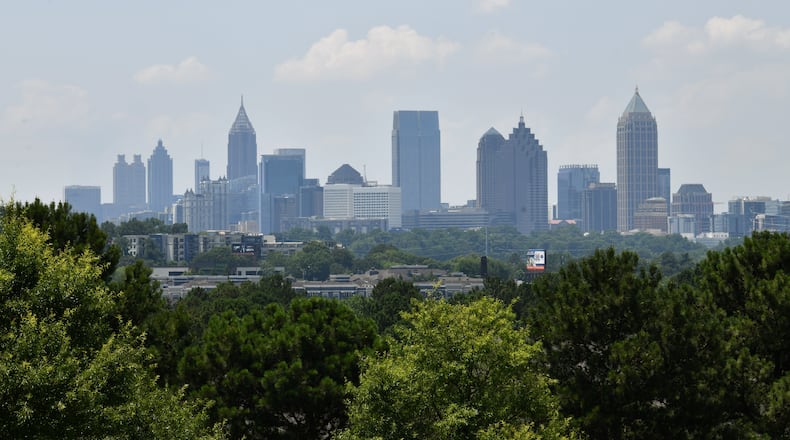A set of modest changes to Atlanta’s tree protection ordinance passed late last year by City Council took effect Thursday, marking the first revisions to the rules governing tree removals and replacements in the city in years.
Still, with tree loss in the city accelerating in recent years, environmentalists say more substantial updates are needed to preserve what remains of Atlanta’s famed canopy — and soon.
The changes establish new rules for planting trees in parking lots and along streets surrounding new residential and commercial developments, and give city arborists more latitude to enforce the rules.
Credit: HYOSUB SHIN / AJC
Credit: HYOSUB SHIN / AJC
Developers must now plant or preserve at least one tree for every eight parking spots and no parking space can be more than 45 feet from a tree. New residential or commercial developments are now required to have trees planted every 40 feet along all surrounding streets. The amendments also include soil volume and spacing requirements to help ensure tree saplings survive, plus restrictions on the kinds of trees that can be planted that favor overstory species native to Georgia.
Due to human-caused climate change, the risk of dangerous heat waves, damaging floods and other extreme weather events is growing in Atlanta. As the planet warms, scientists project that the threats posed by many climate-fueled disasters will increase.
At the same time, tree loss in the city has accelerated.
A 2018 survey conducted by Georgia Tech researchers found the city’s canopy had declined by roughly 1.5 percentage points from where it stood in 2008, with close to half an acre of trees lost each day over that time. Data from the city’s arborist division, reported earlier this year by The Atlanta Journal Constitution, showed the number of tree removals — along with trees classified as dead, dying or hazardous — has exceeded those replaced each year since mid-2013.
In a statement, Atlanta Mayor Andre Dickens called Atlanta’s tree canopy the city’s “most powerful nature-based tool for climate resilience,” and touted a plan to plant thousands more trees around Downtown’s concrete-heavy streetscape.
“The standards set in the updates to the Tree Protection Ordinance — coupled with initiatives like doubling Downtown’s tree canopy with 8,000 trees over five years and others — will further help reduce energy costs, improve our air and stormwater management and raise the overall quality of life for residents,” Dickens said in a statement.
Tree advocates, meanwhile, say the city and city council have more work to do to save “the city in the forest.”
A coalition of environmental groups that have pushed the city for years to modernize its ordinance say meatier issues like recompense — how much it costs to remove a tree — must be addressed.
Credit: HYOSUB SHIN / AJC
Credit: HYOSUB SHIN / AJC
Kathryn Kolb, a conservationist who leads one such tree advocacy group, said the new changes won’t help save existing trees.
“There are some minor improvements — mostly procedural — but no progress has been made on any actual tree protection,” Kolb said. “None of the changes substantively address the problem of tree loss.”
After previous attempts to pass a full revamp of Atlanta’s 20-year-old tree ordinance were bogged down by the competing interests of developers and tree advocates, City Council began a phased approach to updating the rules last year. The changes that took effect Monday represent “Phase 1″ of the ordinance rewrite.
In a statement, Dickens’ office indicated that with these changes now in effect, the city is ready to take on “Phase 2,” which it said would “encompass tree preservation, recompense, and an income-sensitive tree replacement program.”
The city said a draft of those proposed changes would be ready by fall or winter this year.
A note of disclosure
This coverage is supported by a partnership with 1Earth Fund, the Kendeda Fund and Journalism Funding Partners. You can learn more and support our climate reporting by donating at ajc.com/donate/climate/
About the Author
Keep Reading
The Latest
Featured





